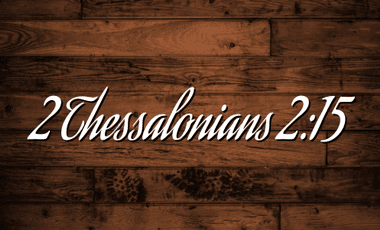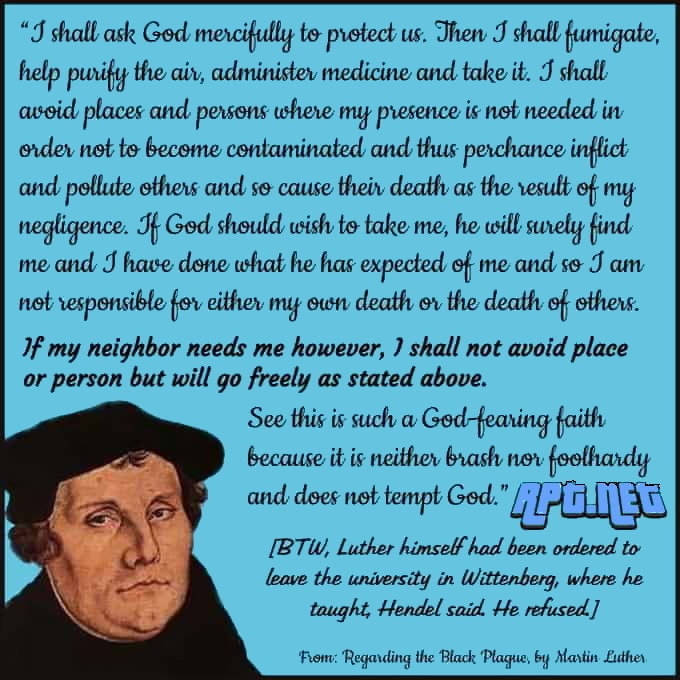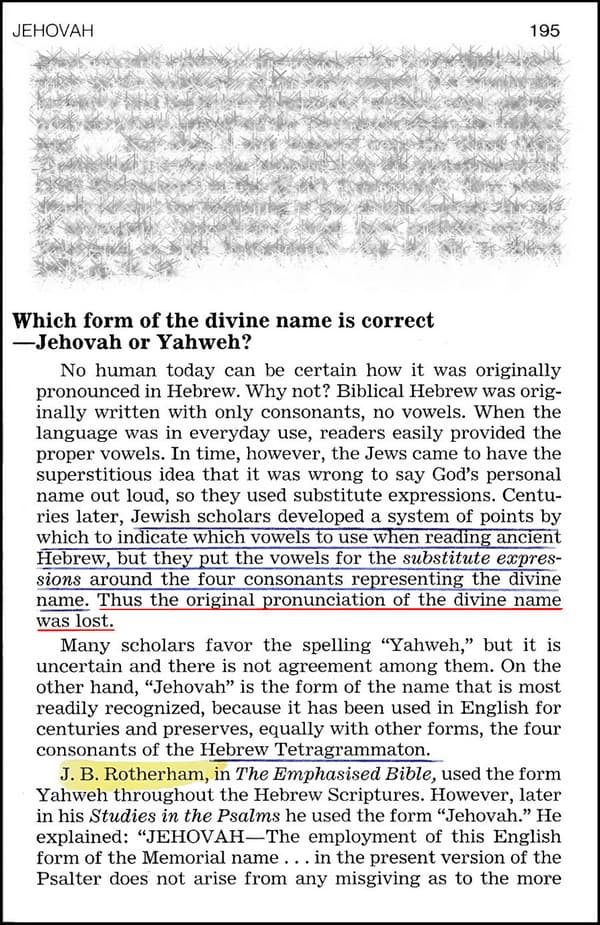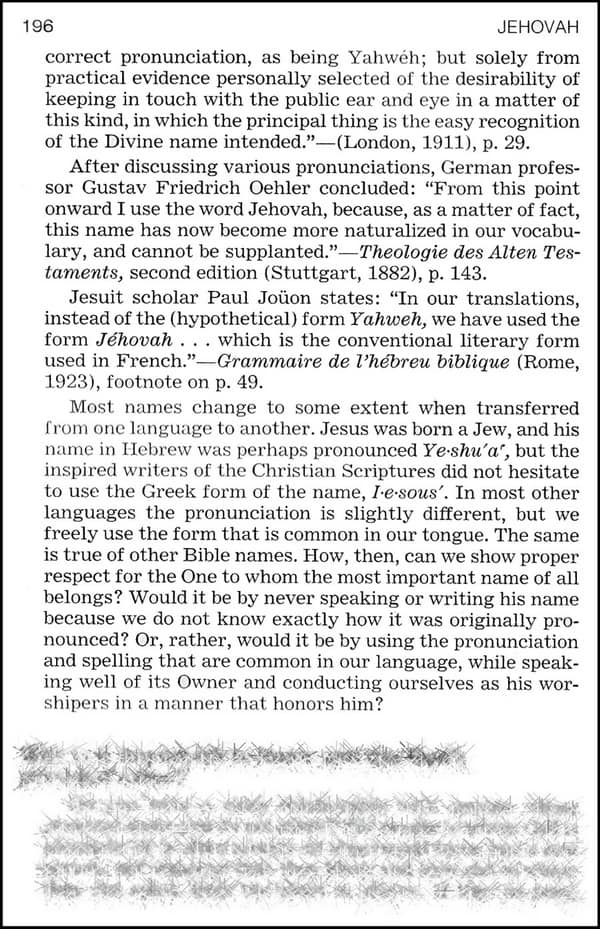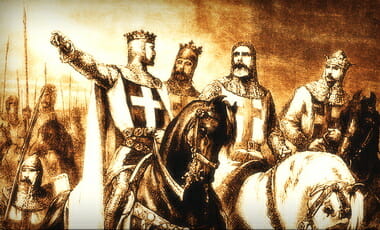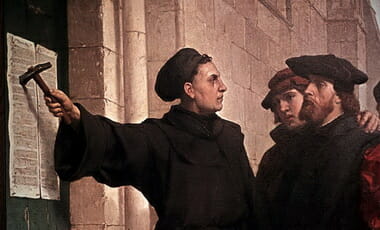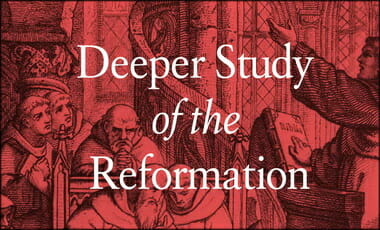Martin Luther believed that music was second only to Scripture in its ability to elevate the soul. In this brief clip, R.C. Sproul, W. Robert Godfrey, Steven Lawson, and Stephen Nichols discuss some of Luther’s most famous and heartfelt hymns.
The below is from Vishal Mangalwadi’s book, The Book that Made Your World: How the Bible Created the Soul of Western Civilization, chapter one:
Chapter One
The West Without Its Soul
From Bach To Cobain
For two hundred years we had sawed and sawed and sawed at the
branch we were sitting on. And in the end, much more suddenly than
anyone had foreseen, our efforts were rewarded, and down we came.
But unfortunately there had been a little mistake: The thing at the
bottom was not a bed of roses after all; it was a cesspool full of barbed
wire . . . It appears that amputation of the soul isn’t just a simple
surgical job, like having your appendix out. The wound has a tendency
to go septic.
—George Orwell, Notes on the Way, 1940
On April 8, 1994, an electrician accidentally discovered a dead body in Seattle, Washington. A shotgun had blown the victim’s head into unrecognizable bits. The police investigation concluded that the victim of this ghastly tragedy was the rock legend Kurt Cobain (b. 1967) and that he had committed suicide a few days earlier. Cobain’s previous attempts at suicide by drug overdose had been unsuccessful. His beautiful wife, singer Courtney Love, is said to have called the police multiple times to have them confiscate his guns before he killed himself or harmed others.
Cobain, the lead singer and gifted guitarist for the rock band Nirvana, captured his generation’s loss of anchor, center, or soul so effectively that their album Nevermind sold ten million copies, displacing Michael Jackson at the top of the charts.
The phrase “never mind” means “don’t bother,” “don’t concern yourself.” Why should you mind, if nothing is true, good, or beautiful in any absolute sense? Should a man be bothered about his adorable daughter’s ongoing need for a father? “Never mind” is a logical virtue for a nihilist who thinks that there is nothing out there to give meaning and significance to anything here —be it your daughter, wife, or life. In contrast, the modern West was built by people who dedicated their lives to what they believed was divine, true, and noble.
Nirvana is the Buddhist term for salvation. It means permanent extinction of one’s individual existence, the dissolution of our illusory individuality into Shoonyta (void, nothingness, or emptiness). It is freedom from our misery-causing illusion that we have a permanent core to our being: a self, soul, spirit, or Atman.
Here is a sample lyric expressing Cobain’s view of salvation as silence, death, and extinction:
Silence, Here I am, Here I am, Silent.
Death Is what I am, Go to hell, Go to jail . . .
Die[1]
As the news of Cobain’s suicide spread, a number of his fans emulated his example. Rolling Stone magazine reported that his tragic death was followed by at least sixty-eight copycat suicides.[2]
“Hey, hey, ho, ho, Western Civ has got to go!” The Stanford students of the 1960s who chanted for the demise of the Western civilization were disgusted with hypocrisy and injustices in the West. Yet, their rejection of the soul of their civilization yielded something very different from the utopia they sought. Diana Grains, in Rolling Stone, noted that prior to the 1960s, teenage suicide was virtually nonexistent among American youth. By 1980 almost four hundred thousand adolescents were attempting suicide every year. By 1987 suicide had become the second largest killer of teens, after automotive accidents. By the 1990s, suicide had slipped down to number three because young people were killing each other as often as they killed themselves. Grains explained these rising figures among the offspring of the ’60s generation:
The 1980s offered young people an experience of unsurpassed social violence and humiliation. Traumatized by absent or abusive parents, educators, police and shrinks, stuck in meaningless jobs without a livable wage, disoriented by disintegrating institutions, many kids felt trapped in a cycle of futility and despair. Adults . . . [messed]-up across the board, abandoning an entire generation by failing to provide for or protect them or prepare them for independent living. Yet when young people began to exhibit symptoms of neglect, reflected in their rates of suicide, homicide, substance abuse, school failure, recklessness and general misery, adults condemned them as apathetic, illiterate, amoral losers.[3]
According to his biographers, Cobain’s early years had been happy, full of affection and hope. But by the time he was nine years old Cobain was caught in the crossfire between his divorcing parents. Like far too many marriages in America, his parents’ marriage had devolved into an emotional and verbal battlefield. One of Cobain’s biographers, commenting on a family portrait when Kurt was six, said, “It’s a picture of a family, but not a picture of a marriage.”[4] After the divorce, Kurt’s mother started dating younger men. His father became overbearing, more afraid of losing his new wife than of losing Kurt. That parental rejection left him displaced, unable to find a stable social center, incapable of maintaining constructive emotional ties either with his peers or with his parents’ generation. That instability inflicted a deep wound in Cobain’s soul that could not be healed by music, fame, money, sex, drugs, alcohol, therapy, rehabilitation or detox programs. His inner anguish made it easy for him to accept the Buddha’s first noble truth that life is suffering.
Psychotherapy failed Cobain. Having questioned the very existence of the psyche (roughly, the self or soul), secular psychology is now a discipline in decline. Sigmund Freud and Carl Jung believed in the existence of self,[5] but their followers now recognize that their faith in “self” was a residual effect of the West’s Christian past—Jung’s father, for example, was a clergyman.
Jung’s truly secular followers, such as James Hillman, are recasting the essence of his theory. An increasing number of thinking people are recognizing that theoretically it is impossible to practice psychology without theology. Six centuries before Christ, the Buddha already knew that if God does not exist, then the human self cannot exist either. Therefore, he deconstructed the Hindu idea of the soul. When one starts peeling the onion skin of one’s psyche, he discovers that there is no solid core at the center of one’s being. Your sense of self is an illusion. Reality is nonself (anatman).
You don’t exist. Liberation, the Buddha taught, is realizing the unreality of your existence.
This nihilism is logical if you begin with the assumption that God does not exist. However, it is not easy to live with the consequences of this belief, or rather, this nonbelief in one’s own self. To say “I believe that ‘I’ don’t exist” can be devastating for sensitive souls like Cobain. His music—alternately sensitive and brash, exhilarating and depressed, loud and haunted, anarchic and vengeful—reflected the confusion he saw in the postmodern world around him and in his own being. While he was committed to a small set of moral principles (such as environmentalism and fatherhood), he was unable to find a stable worldview in which to center those principles.
He was naturally drawn to the Buddha’s doctrine of impermanence: there is nothing stable and permanent in the universe. You can’t swim in the same river twice because the river changes every moment, as does a human being. You are not the same “thing” that you were a moment ago. Cobain’s experience of the impermanence of an emotional, social, spiritual center to his life had tragic consequences. He adopted the philosophical and moral emptiness that other bands lauded as the “Highway to Hell.”[6]
MUSIC AFTER GOD’S DEATH
German philosopher Friedrich Nietzsche (AD 1844–1900) realized that having killed God, Europe could not possibly save the civilizational fruits of its faith in God. But not even Nietzsche realized that one philosophical implication of God’s demise would be the death of his own self. For fifteen hundred years prior to Nietzsche, the West had followed St. Augustine (AD 354–430) in affirming every human being as a trinity of existence (being), intellect, and will. After denying the existence of the Divine Self, it became impossible to affirm the existence of the human self. Therefore, many intellectuals are reverting to the Buddhist idea that the self is an illusion. As contemporary Jungian psychologist Paul Kuglar explained, in the postmodern philosophy, Nietzsche (the speaking subject) is dead—he never existed, for individuality is only an illusion created by language.[7]
Deconstructionists blame language for creating the illusion of the self, but the Buddha blamed the mind. It cannot be God’s image. Therefore, the mind had to be a product of primeval cosmic ignorance, Avidya. The Buddha’s rejection of the self made sense to the classical skeptics such as Pyrrho of Elea (360–270 BC), who traveled to India with Alexander the Great and interacted with Buddhist philosophers. After returning to Greece, he established a new school of skeptical philosophy to teach that nothing is truly knowable. If so, why should anyone pay philosophers to teach anything? No wonder education, philosophy, and science declined in Greece.
Denying the reality of a spiritual core as the essence of every human being makes it hard to make sense of music, because music, like morality, is a matter of the soul. Those who think that the universe is only material substance and the soul is an illusion find it hard to explain music. They have to assume that music evolved from animals, but none of our alleged evolutionary cousins make music. (Some birds do “sing,” but no one has proposed that we, or our music, evolved from them.) Charles Darwin thought that music evolved as an aid to mating. That might be believed if rapists took bands to lure their victims. By evolutionary psychology, rape could be seen as a natural form of mating and morality an arbitrary social control.
Music serves no biological purpose. As Bono, the lead singer for U2 put it, “music is a matter of the spirit.” Some contemporary music moves toward God—for example, Gospel Music. Other genres—for example, the Blues— may be running away from God and seeking redemption elsewhere. Nevertheless “both recognize the pivot that God is at the center of the jaunt.”[8] Even in the Bible, all prophetic poetry is not singing praises to God. Beginning with Job, biblical poetry includes penetrating questioning of God in the face of suffering and injustice. Music that blames God for evil, affirms God as the only available source of meaning and our right to pass moral judgment.
The Buddhist skepticism that Pyrrho brought to Europe is logical and powerful. The West escaped its paralyzing influence only because thinkers such as St. Augustine succeeded in refuting it. Augustine affirmed the certainty of the human self because the Bible taught that God existed and had created man in his own image. Augustine also affirmed the validity of words. He believed language can communicate truth because communication is intrinsic to the triune God and man is made in the image of a God who communicates. Now, having rejected those biblical foundations, the West has no basis for escaping the Buddha’s radical pessimism.
In spite of—or perhaps because of—his inner chaos, Cobain remained so popular that in 2008 the music industry ranked him as the number one “Dead Artist.” His albums outsold Elvis Presley’s. Years after his death, in 2002 his widow was able to sell the scraps and scribbles in his journals to Riverhead Books for (reportedly) four million dollars. Two decades ago, a publisher anywhere in the world would have rejected his notes as meaningless, misspelled graffiti. At the dawn of the twenty-first century in America, cultural gatekeepers rightly recognize that Cobain represents America’s soullessness better than most celebrities. In a sample of relatively meaningful meaninglessness, he wrote:
I like punk rock. I like girls with weird eyes. I like drugs. (But my Body And mind won’t allow me to take them.) I like passion. I like playing my cards wrong. I like vinyl. I like feeling guilty for being a white, American male. I love to sleep. I like to taunt small, barking dogs in parked cars. I like to make people feel happy and superior in their reaction towards my appearance. I like to have strong opinions with nothing to back them up with besides my primal sincerity. I like sincerity. I lack sincerity . . . I like to complain and do nothing to make things better.[9]
I have seen entries similar to Cobain’s journals and lyrics in students’ private diaries in art exhibitions in American colleges. Prior to Cobain, in the 1960s and ’70s, countercultural students at these colleges believed they were on the cusp of inaugurating utopia. By Cobain’s time they knew that nihilism leads only to escapism. Steven Blush studied the music of the early 1980s that directly preceded Cobain both chronologically and stylistically. Popularly it is called “hardcore,” a genre marked by its brashness and intentional existence outside the mainstream. He concluded:
Hardcore was more than music—it became a political and social movement as well. The participants constituted a tribe unto themselves. Some of them were alienated or abused, and found escape in the hard-edged music. Some sought a better world or a tearing down of the status quo, and were angry. Most of them simply wanted to raise hell. Stark and uncompromising . . . Lots of [messed]up kids “found themselves” through hardcore . . . the aesthetic was intangible. Most bands couldn’t really play that well, and their songs usually lacked craft. They expended little effort achieving prevailing production standards. However, they had IT—an infectious blend of ultra-fast music, thought provoking lyrics, and f[orget]-you attitude.[10]
The postmodern “rebels without a cause” were Living in a world of my own.[11]
Cobain’s music appealed to contemporary America because it was a full-throated disharmony of rage, anguish, hatred, despair, meaninglessness, and obscenity. His song titles included “I Hate Myself, I Want to Die” and “Rape Me” (later changed to “Waife Me”). Most of what Cobain sang cannot be deciphered, and many of his lyrics that can be deciphered have no apparent meaning. Whether he knew it or not, his lyrics were Zen koans, counter-rational sayings such as “what is the sound of one hand clapping?” Such words do not make sense because (in the absence of revelation) reality itself makes no sense. Words are merely mantras—sounds without sense—to be chanted or shouted.
Cobain committed suicide because Nothingness as the ultimate reality does nothing positive. It cannot provide joy to the world, let alone meaning or hope for the mess in one’s life. Its only consequence is to inspire people to seek an exit from the world—Nirvana. A culture of music does not flourish in the soil of nihilism. Cobain’s gift as a musician blossomed because he had inherited a unique tradition of music.
Music seems a natural, perhaps even essential, part of life to the Western mind because it has been an integral part of traditional worship and education. For example, Oxford and Cambridge universities have played pivotal roles in shaping the second millennium. However, a person who has never visited these cities may not know that they are cities of churches and chapels. The chapel is the most important building in traditional colleges and a pipe organ is often the centerpiece of a chapel. That is not the case in every culture.
Turkmenistan is the latest country to put restrictions on music: on state holidays, in broadcasts by television channels, at cultural events organized by the state, in places of mass assembly, and at weddings and celebrations organized by the public.[12] Nations such as Saudi Arabia have had restrictions on music for a long time. In Iran and Afghanistan, women cannot sing on the radio, let alone on television or in person before mixed audiences. In post-Saddam Iraq, radical Muslims have assassinated sellers of music CDs. Mosques do not have keyboards, organs, pianos, orchestras, or worship bands because according to traditional Islam, music is haraam or illegitimate. [The idea that music is “haraam” or is illegitimate is based on Qur’an 17.64, 31.6, and 53.59–62. Historically, Islamic theologians working in the tradition of Qur’anic interpretation developed by Ibn Masood, Ibn Abbas, and Jaabir after the death of Prophet Muhammad have interpreted these passages as condemning all music. Other modern interpreters contend that the Qur’an does not ban music.]
These cultures see Western music as inextricably mixed with immoral debauchery. For them, musicians such as Kurt Cobain are undesirable role models. Indeed, on the cover of his album Nevermind, Cobain brazenly depicted the values he lived by: an infant with a long penis underwater reaching out to a dollar bill on a fishhook. On the back cover, Cobain’s mascot, a chipmunk, sits on a vagina. Open debauchery was a part of “pagan” music until the Bible extricated music from it by recentering the locus of the music to God.
Do not get drunk on wine, which leads to debauchery. Instead, be filled with the Spirit . . . Sing and make music in your heart to the Lord, always giving thanks to God the Father for everything, in the name of our Lord Jesus Christ.[13]
Buddhist monks in Asia developed sophisticated philosophies, psychology, rituals, and psycho-technologies to try to escape life and its sufferings. They perfected techniques such as Vipasana [Yoga attempts to control breathing in its quest to realize self. Vipasana observes breathing as a means of silencing one’s mind to experience that there is no self or soul inside us but only Nothingness, Emptiness, Void, Shoonyta or Selflessness] to silence not just their tongues but also their thoughts. Buddhism originated in India and prior to its disappearance enjoyed powerful political patronage for centuries. It built such massive monasteries that Buddhist art is a cherished aspect of our national heritage. Yet, Buddhism left no discernible musical tradition or instrument in India. No Buddhist monk started a band such as Nirvana, because in Buddhism salvation is not a heaven filled with music.[14] As a pessimistic philosophy of silence it could not produce music of hope and joy. Buddhism could not celebrate existence because it saw suffering as the essence of life. Some forms of modern Buddhism have embraced music, partially because of the efforts of Western converts, such as Kurt Cobain, who grafted the Western tradition of religious music into the Buddhist faith.
To say that music is a new phenomenon in Buddhist temples is not to suggest that pre-Buddhist Tibet or China had no music.[15] Music is intrinsic to the universe and to human nature even if some worldviews, including Darwinism, do not understand, recognize, or promote it. China’s fertility cults and sexual rites involved choirs of boys and girls singing alternately and together to symbolize Yin and Yang dualism as early as 2000 BC. A thousand years prior to that, the worshippers in Sumero-Mesapotamia used music in their temple rituals.
The musical ragas of Hindu magical rituals have survived for thirty-five hundred years. Most of the Vedas are hymns and chants. The Vedic priests understood sound as well as anyone else in the world and developed a highly complex system of chanting, even if Hindu monks and priests did not develop music into the complex medium that Western music became. Thankfully this is changing now. Bollywood has played a great role in inspiring some Hindu ashrams to develop great music. It has also raised the standard of Qawwali, which began as a part of Sufi tradition [Sunnis and Shiites consider Sufism a Muslim heresy], but is now loved by Hindus as well as by Muslims—including in Pakistan.
WRITING MUSIC INTO THE WEST’S DNA
St. Augustine, the author of the six-volume On Music, was a key figure in inserting music into Western education and worldview. His first five volumes are technical and could have been written by a Greek philosopher. But Augustine was most excited about his sixth book, which gives a biblical philosophy of music. Music is, of course, integral to the Bible, in which the longest book is Psalms. The last psalm, for example, asks creation to praise the Lord with the trumpet, lute, harp, tambourine, strings, pipe, and cymbals.
Why are these physical instruments able to make music? Augustine saw that the scientific basis or essence of music lies in mathematical “numbers” or scores at the core of creation. Since music is mathematical, Augustine argued, it must be rational, eternal, unchangeable, meaningful, and objective—it consists of mathematical harmony. We cannot make a musical sound from just any string. To get a precise note, a string has to have a specific length, thickness, and tension. This implies that the Creator has encoded music into the structure of the universe. This insight was not new. It had been noted by Pythagoras (570–490 BC), whose school Plato attended before starting his Academy. Augustine promoted this “pagan” insight because the Bible presented a view of creation that explained why matter could make music.
Augustine taught that while this musical code is “bodily” (physical), it is made and enjoyed by the soul. For example, the book of Job deals with the problem of inexplicable suffering. In it God himself tells Job of the connection between music and creation: “Where were you when I laid the foundation of the earth? . . . when the morning stars sang together and all the sons of God shouted for joy?”[16]
The Bible taught that a sovereign Creator (rather than a pantheon of deities with conflicting agendas) governs the universe for his glory. He is powerful enough to save men like Job from their troubles. This teaching helped develop the Western belief of a cosmos: an orderly universe where every tension and conflict will ultimately be resolved, just as after a period of inexplicable suffering Job was greatly blessed.
This belief in the Creator as a compassionate Savior became an underlying factor of the West’s classical music and its tradition of tension and resolution. Up until the end of the nineteenth century, Western musicians shared their civilization’s assumption that the universe was cosmos rather than chaos. They composed consonance and concord even when they experienced dissonance and discord. That is not to suggest that classical music did not express the full range of human emotions. It did. A bereaved composer would write a tragic piece; someone abandoned by his love would express his desolation. But such outpourings of a broken heart were understood as snapshots of real life. Given the cultural power of the biblical worldview, no one thought of them as Kurt Cobain did, as evidence of the breakdown of cosmic order or the nonexistence of order in the universe.
In the novel The Silmarillion, J. R. R. Tolkien gives us a beautiful, fictional exposition of the Augustinian perspective on the relationship of music, creation, the fall (evil), and redemption. Tolkien’s Middle-earth experienced much more suffering than the Buddha’s India. Tolkien’s “earth” was to be captured, corrupted, and virtually controlled by evil. Suffering was real, brutal, and awful. Yet the Bible taught Tolkien that the Almighty Creator, who was also a compassionate Redeemer, was loving enough and powerful enough to redeem the earth from the greatest possible mess, sin, and suffering. This helped Tolkien to celebrate creation, both in its origin as well as in its ultimate destiny:
There was Eru, the One, who in Arda is called Iluvatar; and he made first the Ainur, the Holy Ones, that were the offspring of his thought, and they were with him before aught else was made. And he spoke to them, propounding to them themes of music; and they sang before him, and he was glad. But for long while they sang only each alone, or but few together, while the rest hearkened; for each comprehended only part of the mind of Iluvatar from which he came, and in the understanding of their brethren they grew but slowly. Yet ever as they listened they came to deeper understanding, and increased in unison and harmony. . . .
Then Iluvatar said to them: “Of the theme that I have declared to you, I will now that ye make in harmony together a Great Music.”
Then the voices of the Ainur, like unto harps and lutes, and pipes and trumpets, and viols and organs, and like unto countless choirs singing with words, began to fashion the theme of a great music; and a sound arose of endless interchanging melodies woven in harmony that passed beyond hearing into the depths and into the heights, and the places of the dwelling of Iluvatar were filled to overflowing, and the music and the echo of the music went out into the Void, and it was not void.[17]
Prior to becoming a follower of Christ, Augustine had been a professor of Greek philosophy. He knew that although music was encoded into the structure of the physical universe, being finite, it could never provide ultimate meaning to life [Augustine’s intellectual mentor, Plato, believed that epistemologically no finite particular can make sense without an infinite reference point]. Therefore, he reasoned that to be meaningful, music had to be integrated into the ultimate aim of human life, which was to love God and one’s neighbors. To love one’s neighbor is to “always mind” his welfare.
Over the centuries, the influence of Augustine’s biblical philosophy of music kept growing. Originally, church music was dominated by monophonic plainsong, a single line of melody as in the Gregorian chant. Roman Catholic churches began to develop polyphonic music. This style, which combines several differing voice parts simultaneously, began to flourish at Notre Dame (Paris) by the eleventh century. That development in Christian worship laid the foundation for the entire spectrum of Western classical music, religious and secular [Augustine did not have much influence over the Eastern Church and that may be one reason why its music did not develop much beyond the chant].
In the tenth century AD, Augustine’s biblical philosophy of music inspired a group of Benedictine monks to build the world’s largest pipe organ in the cathedral of Winchester, England. The organ required seventy men and twenty-six bellows to supply wind to its four hundred pipes. Technologically, the pipe organ was the world’s most advanced machine until the invention of the mechanical clock. Europe’s organs stood as emblems of the West’s unique desire and ability to use the arts, science, and technology for the glory of God as well as for the relief of humanity’s suffering and toil.
Augustine’s biblical philosophy of music was an important tributary that contributed to the river of mechanical arts that began to flow out of Christian monasteries and churches. This tradition used technology to worship God and to love one’s neighbors.
TAKING MUSIC TO THE MASSES
Martin Luther (AD 1483–1546) took the biblical-Augustinian philosophy of music out of the cloister and choir loft to Europe’s masses. An Augustinian monk and pioneer of the Protestant Reformation, Luther was and remains a polarizing figure. Some love him; others hate him. Yet many critics agree that Luther may have been the most influential figure of the second millennium.
Luther was a “Protestant” because he saw plenty in his world to protest against. But he did not become a reformer simply because he protested. He changed Europe because he found something worth singing about, something worth living for, and something worth dying for. He found a covenant relationship with the Almighty God [Later some Enlightenment thinkers secularized the biblical idea of divine covenant as “social contract.” The idea lies at the root of modern constitutionalism. It enabled the West to become a society built uniquely on trust. See Robert N. Bellah The Broken Covenant: American Civil Religion in Time of Trial (New York: Crossroad Books, 1975)]. A relationship he could count upon. It was a faith, a worldview upon which his decadent world could be rebuilt. Yet, it was far more than an idea or creed. It was a vibrant relationship with someone who was worth dying for; a love affair worthy of songs.
Luther got excited about the Bible partly because it taught that he could not and did not need to do anything to qualify for God’s love. Salvation— forgiveness from sin and the restoration of a person’s relationship with God —was a free gift of grace to be received by the empty hands of faith. The Bible gave Luther a deep, Abraham-like, inner assurance of God’s acceptance. God’s friendship gave such a value and meaning to his life that he had something to sing about. Yes, in a world that had rebelled against the Creator, there was suffering. Yet, because God is love, there is hope for pardon, peace, progress, and prosperity. This gospel made the West uniquely optimistic, enabling it to sing, “Joy to the world”—a message opposite to that of Cobain.
Luther helped this biblical worldview to become the soul of Western civilization. His spiritual followers summed up his discovery of the Bible’s essence in songs of hope, assurance, and certainty, such as “Amazing Grace,” written by reformed slave trader John Newton (1725–1807):
Amazing grace! How sweet the sound
That saved a wretch like me!
I once was lost, but now am found;
Was blind, but now I see.
Luther became a reformer because he realized that in order to conform to God’s Word, all God’s children would need to have that Word in their native languages. He translated the Bible into his own German dialect. His translation went into hundreds of editions and turned his dialect into the “Standard German” for the whole of the German-speaking world. Together with Luther’s German hymnal, his Bible forged the soul of the German-speaking nations. Luther’s work inspired other reformers, such as William Tyndale, who began translating the Bible into English. That crucial beginning made the Bible the soul also of the English-speaking world. Following Jesus and the apostles, the early church sang worship together until Jerome the Great encouraged priests to take over chanted worship in the fifth century. Since then until Luther’s time, congregations rarely sang during Christian worship—and then only in Latin, which they did not understand. By and large it was the priest’s job to worship and pray. Luther rediscovered the New Testament doctrine of the priesthood of all believers [As we shall see in chapter 15, this profound discovery based on 1 Peter 2:9, Revelation 1:6, etc., became an important source of the West’s economic development and political liberty.], which made it necessary for the entire congregation to worship God by singing as well as by prayer and other means. “God,” he believed, “has created man for the express purpose of praising and extolling Him.”[18] Because of his belief in the priesthood of all believers, Luther wrote hymns in the language of his people —German—and brought music to the lungs and lips of even the poorest peasants in the congregation.
For Luther the reformation of the university was second in importance only to the reformation of the Church, and music had to have a prominent role in education as well:
I have always loved music; whoso has skill in this art, is of a good temperament, fitted for all things. We must teach music in schools; a schoolmaster ought to have skill in music, or I would not regard him; neither should we ordain young men as preachers, unless they have been well exercised in music.[19]
In putting music at the heart of worship and at the core of his curriculum of education, Luther simply followed the Jewish (biblical) tradition of temple musicians and singers who were “prophets” or “sons of prophets.” The biblical phrase “sons of prophets” often meant the students of prophets. An early meaning of the phrase “to prophesy” was ecstatic singing accompanied with music.[20] King David—the driving force behind the temple worship in Jerusalem—was Israel’s musician, singer, and poet par excellence. The Bible calls him a “prophet.”[21] The New Testament asked the followers of Christ to seek the gift of prophecy.[22] In the light of the Old Testament, that exhortation had to include learning music, as did the “sons of prophets.”
The modern West confirmed Luther’s educational philosophy that musical literacy produces people with an intuitive awareness of a logical and orderly universe. It is not a coincidence that universities such as Oxford and Cambridge that have a distinctly Christian heritage still hold music in greater respect than most of the universities founded upon secularism during the twentieth century.
THE FLOWERING OF WESTERN MUSIC
It takes barely five minutes to walk from the Bach house at Eisenach, Germany, to the house where Luther had lived as a student, and it takes less than ten minutes to drive up the hill to the castle of Wartburg where Luther translated the New Testament into German. By the time Johann Sebastian Bach (1685–1750) was born, that area had become a Lutheran province. Philosophically, Johannes Kepler reinforced the biblical-Augustinian-Lutheran view of creation and music by teaching that music mirrors the divinely ordained mathematical harmony of the universe. Bach was a musical genius because he was a mathematical genius who received as a part of his education this (non-polytheistic) biblical outlook of an orderly creation. In that mind-set, aesthetics was inseparable from ultimate harmony. One of his biographers, Wilfrid Mellers said,
At the school which Bach attended in Ohrdruf the system of education was little changed from the old [Augustinian-Lutheran] prescription. Music was second in importance only to theology, and was taught by the same master, who believed that music makes the heart ready and receptive to the divine Word and truth, just as Elisius [Elisha] confessed that by harping he found the Holy Spirit.[23]
For Bach, as for Luther, “true music” pursues as its “ultimate end or final goal . . . the honor of God and the recreation of the soul.” Bach believed that music was a “harmonious euphony for the glory of God.”[24] Obviously, this is not meant to suggest that Bach’s musical talent was nurtured only by theological beliefs. His family was a key factor in developing Bach’s talent. In chapter 15 we will see that it was Luther’s exposition of the Bible that made his family different from Cobain’s family. In his formative years, Bach drew heavily on his family’s musical heritage, which extended back to his great-great-grandfather. The Bach clan had developed into an expansive network of musical apprenticeship and encouragement. This network proved to be pivotal in Bach’s development.
What does a German monk, a Roman Pope, and a Spanish Emperor have to do with music history? Today we look at the events that surrounded 15th and 16th Century German music – particularly that of Martin Luther and the Protestant Reformation.
Bach and Cobain shared more in common than their talent for music. They both lost their parents when they were nine years old, Cobain’s parents to divorce and Bach’s to death. A tragic event such as his parents’ death could have irreparably upset Bach’s emotional balance. But back then the “family” was more than parents and children. Johann moved in with his older brother, who taught him to play the organ and develop his talents as a composer. Following his brother’s example, Johann later tutored his own children to become some of the best musicians of their generation. His youngest son became, in his own right, one of the most important influences on Mozart’s work.
It is tempting to interpret the order and harmony of Bach’s music as a metaphorical reflection of the order of his family. The stability and support of his wider family gave Bach the emotional strength to overcome his heartaches. This strength is reflected not only in his life but also in his work. Yet, the family alone cannot explain his ability to celebrate “The Passion” (suffering) of St. John or St. Matthew. This ability to celebrate suffering came from his faith in the resurrection— God’s triumph over suffering and death.
Philosophically speaking, Bach’s inner power to cope with his parents’ death came from his belief in a sovereign and loving God. His life and his compositions were saturated with the book that had given him profound personal and social hope.[25] Life taught him that evil was real and powerful, but the Bible taught him that God was at work redeeming the world, working all things together for good.[26] This biblical faith had been the key to the optimism and music of Western civilization: for Augustine as the Roman Empire was collapsing around him, for Luther as his own life was threatened by a powerful empire and a corrupt religious leadership, and for Tolkien as he lived through the horror of two World Wars.
These people knew evil and suffering, as did the Buddha and Cobain, but the difference was that the Bible gave them a basis for hope in this life as well as in the next. This biblical faith in a Creator who made human beings in his image and loved them enough to come to save them, made it possible for the West to sing, “O come, all ye faithful/ Joyful and triumphant.” In contrast, Cobain’s career demonstrates that without this faith the West’s hope and celebration are turning into a sense of abject despair. If we may borrow the language of musicologists, the West is losing its “tonality”—its “home/ key note,” its soul, its center, the reference point that allowed the relaxation/resolve of tension.
THE LOSS OF “TONALITY” IN WESTERN MUSIC
For centuries, Western music was tonal. That is, its hallmark was loyalty to a tonic key/home note. Every single piece gave preference to this one note (the tonic), making it the tonal center to which all other tones were related. The breakup of tonality in Western music is said to have begun with Adolf Hitler’s hero, Richard Wagner (1813–1883), who experimented with “atonality” in his opera Tristan and Isolde. Claude Debussy (1862–1918), Grand Master of the occult Rosicrucian lodges in France, took that experiment further. The West’s descent into the chaos of atonality accelerated in the twentieth century in Vienna, the capital of Europe’s cultural decadence [for example, the second Viennese school of Schoenberg, Webern and Berg].
Eventually the atonal composers had to create a new organization in their art to replace tonality—an artificial tonality called serialism. By dismissing tonality—the center—they lost something they hadn’t considered—form. Technically, Cobain retained tonality, but in a philosophical sense the loss of tonality in Western culture culminated in Cobain’s music, the icon of America’s nihilism and an unfortunate victim of a civilization that is losing its center, its soul. It must be added in his defense that by killing himself, Cobain demonstrated that he lived by what he believed. His sincerity makes him a legitimate icon. Most nihilists do not live in the grip of what they believe to be the central truth about reality. For example, French existentialists Sartre and Camus advocated choice in spite of the nihilism they embraced. In so doing they made a way out of Cobain’s problem. For them suicide was not necessary if one could create his own reality by choices.
Cobain remains popular because while many people claim to be nihilists, they don’t fully live it out. He did. He lived without creating his own reality through choice (or tonality through serial technique). He lived in the nihilism, in the “atonality,” and in that nihilism he died. In that sense Cobain stands as the direct opposite of the life, thoughts, and work of J. S. Bach. Whereas Bach’s music celebrated life’s meaning as the soul’s eternal rest in the Creator’s love, Cobain became a symbol of the loss of a center and meaning in the contemporary West.
While Western music has gone through dozens of phases with thousands of permutations since the time of Luther and Bach, in some ways it was only during the 1980s that a phenomenon like Kurt Cobain became possible. The rejection of a good, caring, and almighty God and a rejection of the biblical philosophy of sin ensured that there was no way to make sense of suffering— personal, societal, or environmental. Reality became senseless, hopeless, and painful.
THE AMPUTATION OF THE SOUL
Today, many people reject the Bible because they consider it to be irrational and irrelevant. Others believe it to be responsible for racial prejudices, sectarian bigotries, slavery, the oppression of women, the persecution of witches, opposition to science, the destruction of the environment, discrimination against homosexuals, and religious wars. However, this criticism itself reveals the powerful influence the Bible had during the last millennium. During that time, hardly any intellectual position or social practice could become mainstream in Christendom unless it could be defended on biblical grounds, real or mistaken; nor could beliefs and practices be challenged unless their opponents demonstrated that their call for reform was biblical.
Criticisms of the Bible are recognition of its unique cultural power. It has been the West’s intellectual and moral compass, the “sacred canopy” (Peter Berger) that gave legitimacy to its values and institutions. The West’s rejection of the Bible ushered in what historian Jacques Barzun called its “decadence.”[27] It brought an abrupt end to the Modern age [by that I mean the period from the sixteenth through the midtwentieth century when the Bible remained the dominant culture-shaping force, even though skeptics, agnostics, and atheists kept condemning the Bible], just when Western civilization seemed set to win the world. Now, having amputated the Bible, the Western educational machinery is producing “strays,” lost like Cobain. It can make good robots but it cannot even define a good man. The postmodern university can teach one how to travel to Mars but not how to live in one’s home or nation.[28]
India-born British author George Orwell (1903–50) was a socialist, inclined toward atheism. The horrors of Fascism, Nazism, Communism, and the two World Wars forced him to face the consequences of the “amputation of the soul.” In his “Notes on the Way,” Orwell wrote that the writers who sawed off the West’s soul included “Gibbon, Voltaire, Rousseau, Shelley, Byron, Dickens, Stendahl, Samuel Butler, Ibsen, Zola, Flaubert, Shaw, Joyce —in one way or another they are all of them destroyers, wreckers, saboteurs.”
These “Enlightenment” writers led the West into its present darkness.
In his essay Orwell was reflecting on Malcolm Muggeridge’s book The Thirties, which describes the damage these writers had done to Europe. Muggeridge, then still an atheist, was astute enough to perceive that,
we are living in a nightmare precisely because we have tried to set up an earthly paradise. We have believed in “progress.” Trusted to human leadership, rendered unto Caesar the things that are God’s. . . . There is no wisdom except in the fear of God; but no one fears God; therefore there is no wisdom. Man’s history reduces itself to the rise and fall of material civilizations, one Tower of Babel after another . . . downwards into abysses which are horrible to contemplate.[29]
I first discovered the Bible as a student in India. It transformed me as an individual and I soon learned that, contrary to what my university taught, the Bible was the force that had created modern India. Let me, therefore, begin our study of the book that built our world by telling you my own story.
Epigraph: George Orwell’s “Notes on the Way” was first published in Time and Tide, March 30—April 6, 1940. It is reprinted in Collected Essays, Journalism and Letters of George Orwell (Harcourt, Brace & World, 1968).
NOTES
[1] “Endless, Nameless” on Nevermind (Los Angeles: Geffen Records, 1991). This song is a hidden track at the end of some copies of the CD.
[2] The Rolling Stone editors, Cobain (Boston: Little, Brown and Company, 1994), 128. See “Suicidal Tendencies” by Diana Grains, 128–32.
[3] Ibid.
[4] Charles R. Cross, Heavier Than Heaven (NY: Hyperion, 2001), 15.
[5] Freud’s second topography undermines the modern, Cartesian understanding of selfhood that most in the West understand by “self.” Freud’s self is decentered.
[6] Band AC/DC.
[7] For a simple summary see Connie Zweig’s essay, “The Death of the Self in a Postmodern World” in The Truth About The Truth: Deconfusing and Re-Constructing the Postmodern World, ed. Walter Truett Anderson (NY: Penguin Putnam, 1995), 145–150.
[8] Rolling Stone, November 3, 2005, 54.
[9] Kurt Cobain, Journals (NY: Riverhead Books, 2003), 108–09.
[10] Steven Blush, American Hardcore: A Tribal History (Los Angeles; NY: Feral House, 2001), 9.
[11] A lyric by Agent Orange, “Living in Darkness,” Agent Orange (Warner/Elektra/ Atlantic, 1981).
[12] On February 25, 2009, the Bureau of Democracy, Human Rights and Labour submitted the 2008 Human Rights Report for Turkmenistan: “The government demonstrated little or no support for non-Turkmen music, but classical music was taught and performed throughout the country. The previously banned government-supported symphony orchestra was reestablished at the National Cultural Center and began monthly concerts of Turkmen and world classical music. The president decreed that the circus reopen, and the first opera performance took place in June. Traditional local music, which had not been performed for years, was played in concerts and social events.” US STATE DEPT (accessed January 16, 2011).
[13] Ephesians 5:18–20 NIV.
[14 ] For a biblical description of music in heaven, please see Revelation 5:7–9, 14:1– 3, 15:1–4.
[15] “Tibetan Buddhist Monk Nominated for Grammy award,” 3 February 2006, International Campaign for Tibet (accessed December 4, 2010).
[16] Job 38:4–7.
[17] J. R. R. Tolkien, The Silmarillion (Boston and NY: Houghton Mifflin Company, 2001), 15–16. Tolkien’s fictional passage is an expression of the Bible’s teaching in Job 38, John 1, and the book of Revelation.
[18] Martin Luther’s Foreword to Georg Rhau’s Symphoniae Lucundae, a collection of chorale motets published in 1538, reprinted in From Liturgy and Hymns, ed. Ulrich S. Leupold; trans. Paul Zeller Strodach; vol. 53 of Luther’s Works, American Edition, ed. Jaroslav Pelikan and Helmut T. Lehmann (Philadelphia: Fortress, 1965).
[19] Martin Luther, The Table Talk of Martin Luther, trans. and ed. William Hazlitt (London: H. G. Bohn, 1857), 340.
[20] For example, see 1 Samuel 19:18–24 or 1 Chronicles 25:1–6. “David and the chiefs of the service also set apart for the service the sons of Asaph, and of Heman, and of Jeduthun, who prophesied with lyres, with harps, and with cymbals. The list of those who did the work and of their duties was: Of the sons of Asaph . . . who prophesied under the direction of the king. Of Jeduthun, the sons of Jeduthun . . . who prophesied with the lyre in thanksgiving and praise to the LORD. Of Heman, the sons of Heman . . . the king’s seer, according to the promise of God to exalt him . . . They were all under the direction of their father in the music in the house of the LORD with cymbals, harps, and lyres for the service of the house of God.”
[21] Acts 2:30.
[22] 1 Corinthians 14:1.
[23] Wilfrid Mellers, Bach and the Dance of God (Oxford: Oxford Univ. Press, 1981), 82.
[24] Christoph Wolff, Johann Sebastian Bach: The Learned Musician (NY: Norton, 2000), 8.
[25] Ulrich Meyer, Biblical Quotations and Allusions in Cantata Libretti of Johann Sebastian Bach (London: Scarecrow Press, 1997), 177–216. Bible references that Bach quoted or alluded to in his compositions and writings.
[26] Romans 8:28.
[27] Jacques Barzun, From Dawn to Decadence: 1500 to the Present, 500 years of Western Cultural Life (NY: HarperCollins, 2000). His concept of “decadence” is explained in his introduction.
[28] Stanley Fish, who retired as the Dean of the College of Liberal Arts and Sciences at the Univ. of Illinois at Chicago argued in an article, “Why We Built the Ivory Tower,” NY Times, May 21, 2004, that the Univ. should not even try to teach morality or good citizenship. He wrote, “Performing academic work responsibly and at the highest level is a job big enough for any scholar and for any institution. And, as I look around, it does not seem to me that we academics do that job so well that we can now take it upon ourselves to do everyone else’s job too. We should look to the practices in our own shop, narrowly conceived, before we set out to alter the entire world by forming moral character, or fashioning democratic citizens, or combating globalization, or embracing globalization, or anything else.”
[29] Ibid. Quoted by Orwell.


